Cite this document
(American Born Middle Eastern Children Research Paper, n.d.)
American Born Middle Eastern Children Research Paper. Retrieved from https://studentshare.org/social-science/1767951-how-arab-americans-childrenadolescents-are-able-to-hold-on-to-their-cultural-background-and-heritage-while-still-actively-engaging-in-the-american-lifestyle-as-us-citizens
American Born Middle Eastern Children Research Paper. Retrieved from https://studentshare.org/social-science/1767951-how-arab-americans-childrenadolescents-are-able-to-hold-on-to-their-cultural-background-and-heritage-while-still-actively-engaging-in-the-american-lifestyle-as-us-citizens
(American Born Middle Eastern Children Research Paper)
American Born Middle Eastern Children Research Paper. https://studentshare.org/social-science/1767951-how-arab-americans-childrenadolescents-are-able-to-hold-on-to-their-cultural-background-and-heritage-while-still-actively-engaging-in-the-american-lifestyle-as-us-citizens.
American Born Middle Eastern Children Research Paper. https://studentshare.org/social-science/1767951-how-arab-americans-childrenadolescents-are-able-to-hold-on-to-their-cultural-background-and-heritage-while-still-actively-engaging-in-the-american-lifestyle-as-us-citizens.
“American Born Middle Eastern Children Research Paper”, n.d. https://studentshare.org/social-science/1767951-how-arab-americans-childrenadolescents-are-able-to-hold-on-to-their-cultural-background-and-heritage-while-still-actively-engaging-in-the-american-lifestyle-as-us-citizens.


